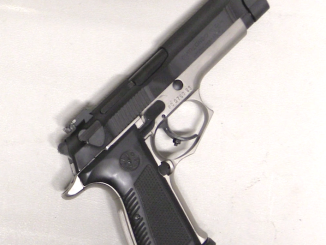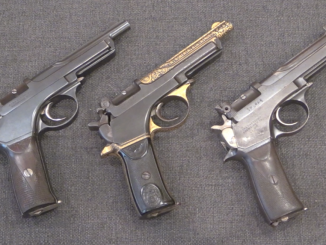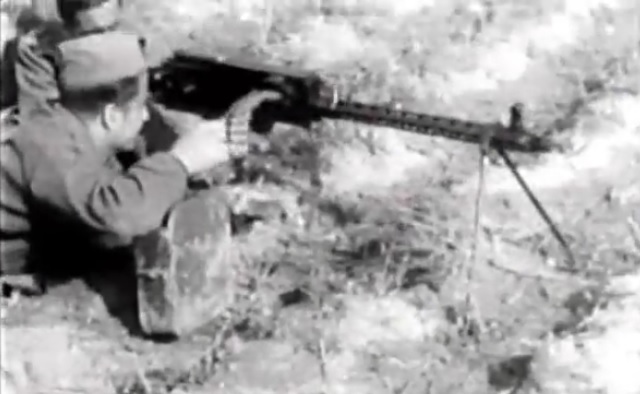The Campo-Giro was Spain’s first indigenous self-loading military pistol, adopted in 1912 to replace the Belgian 1908 Bergmann-Mars. Only a small number were made of the original M1913 variety, with the vast majority being the later and slightly more refined M1913/16. This particular example at RIA is an early one, and particularly interesting to look at for that reason. The gun is a straight blowback design in 9mm Largo, and only lasted as Spain’s standard pistol until its descendent, the Astra 400, was adopted in 1921.
Related Articles

Semiauto pistol
Llama M87: Everything You Would Want for IPSC (at the time)
The Llama M87 was Gabilondo y Cia’s high-end competition pistols based on the M82 action, and made in both 9mm Parabellum and 7.65mm Parabellum. This was mechanically a copy of the Beretta 92 system, and […]

Semiauto pistol
La Lira: A Spanish Copy of the Mannlicher 1901
The Spanish firm of Garate Anitua y Cia manufactured this copy of the Mannlicher 1901/1905 pistol for just a brief period around 1910. It is not a straight copy, as the Mannlicher was chambered for […]

Belt-fed
Three Videos: Finland, Spain, and Hungary
May 25, 2015
Ian McCollum
Belt-fed, Bolt Action Rifles, Heavy MGs, Light MGs, Submachine Guns, Video
30
From Vesamatti, a Finnish gunsmith student who reads the site, we have this neat video of a few older Finnish Army machine guns. The KP-31, KP-44, Sten, KVKK, and DP-27. Not guns we get all […]

Another example of how there is so much more to mechanical design that just getting something to work: there are so many other considerations such as ease of maintenance, tooling requirements, manufacturing processes (e.g. stamping vs. machining), supply chain considerations, etc.
Power-wise, the 9 x 23mm Bergmann-Bayard/Largo is very close to the .38 Super Auto (125-grain @ 1190 for 390 FPE). It also feeds very reliably in .38 Super Auto-chambered pistols, and makes a nice, relatively mild practice round in a 9 x 23mm Winchester-chambered 1911.
One tip on field-stripping and reassembling the Campo-Giro. When getting the breechblock out, holding the pistol vertically, muzzle up, just above a tabletop (in fact, resting the tip of the butt heel on the tabletop itself), lets the table serve as the “stop” to control the breechblock’s rather vigorous departure.
When reassembling, holding the pistol muzzle down with the barrel and slide front end pressing down against the tabletop makes reconnecting the breechblock and slide a bit easier.
I don’t think it’s a coincidence that the later Astra 400 and its 9 x 19mm “little brother”, the 600, were considerably simpler inside than any variant of the Campo-Giro. After all, simplicity is rather the point of a blowback over a locked-breech system to begin with.
Having one with inner workings roughly as complex as a reciprocating steam engine sort of defeats the whole purpose of the exercise.
cheers
eon
IDK what was reliability of Campo Giro, but I know that in Yugoslavia during WW2 Astra 600 was hated with passion as it was quite a jam-o-matic.
Probably only other pistol that was that strongly disliked was Frommer Stop.
The Frommer wasn’t reliable? That’s too bad, I think it is the neatest little pistol.
It was considered very sensitive to dirt and prone to mechanical breakages. After the war, up until 1970s you could find them dirt cheep, none wanted them
Other then Astra 400 and Frommer Stop everything else was liked and was often a status symbol.
I have one of these, but it needs some parts. Grr!
Just a guess that the part you need for your frommer stop is an extractor and/or ejector. Based on my own f.s. Marstar in Canada was my source of the latter, currently no idea where to get the former
No, for a Campo-Giro!
This being blowback operated makes it, for the size of round, truly unusual. I’d like to know if the design, right from start was based on theory (momentum of bullet vs. momentum of slide), or just purely result of experimentation and see what happens.
If it was not possible this way, would the pistol ended up with locked breech or designer took little bit of chance?
It’s not that unusual, really. There were quite a few major-caliber blowback autos developed in the early days;
Schoeboe 1902- fired a .45 caliber bullet with an aluminum jacket and a wooden core weighing 63 grains at over 1600 FPS.
Beretta M1915/19/23 series- 9 x 19mm Glisenti, a “short-loaded” 9mmP equivalent to the 9 x 20SR Browning. (Scaled down, it “evolved” into the Beretta M1933/35 series used in WW2.)
Walther Model 6- a scaled-up Model 4 .32 in 9 x 19mm. About 1,100 made during WW1 as an “emergency” weapon for the Reichswehr. Also the original MP- a scaled-up PP in 9 x 19mm, less than a hundred made in 1932-33.
Jo-Lo-Ar- Spanish pistol with a folding “cocking lever. No slide-retraction grooves on many of them for this reason. Also no trigger guard for no reason anyone in their right mind would consider reasonable. 9mm Largo, .45 ACP(!), and (more sensibly) .32 and .380 ACP.
Yato- Japanese WW2 experimental pistol, 8mm Nambu. About 50 made late 1944-early ’45.
Bernadelli- Made in mid-’50s, about 100 total. 9 x 19mm, enlarged copy of their .32 pocket auto. Imported (briefly) by A.F. Stoeger.
MAB- Model R, Cal. “380P” (9 x 19mm). Originally straight-blowback with a barrel buffer, later a rotating-barrel locked-breech version was built. Less than 1800 known to have been made. Marketed in the US in 1959-63.
Tarn- WW2 experimental pistol made for British Army by Swift Rifle Co. Designed by Polish ordnance engineers from Radom works. 9 x 19mm, only 9 known to have been built.
And that’s not even including the blowbacks like the modern-day Hi-Points in 9mm, .45, .40, etc. Or supposedly “delayed blowback” arms like the Kimball in .30 USC. Or more reasonable blowbacks like the FN M1903 Grande Model or the Manufrance “Type Armee”, both in 9 x 20SR Browning.
Most “major-caliber” blowbacks try to delay breech opening by using powerful recoil springs, a heavy slide assembly, or both. Most end up with the breech opening with high residual pressure still extant, anyway.
Pretty much all are a major PITA to rack due to the heavy springs. Altogether, the high-powered blowback pistol is a lot less “user-friendly” than the average short-recoil, locked-breech self-loader.
cheers
eon
That is quite a list and I appreciate you put up effort to obviate it.
Well, hard to strike right balance with this type of action, that’s for sure. Spewing hot gas out of chamber is dangerous occurrence; not exactly user friendly, as you say.
In his novel Pallas, L. Neil Smith came up with a neat “work-around” for the problem. Build a blowback autopistol with very powerful springs to keep the breech shut until pressure drops to a safe level and which also cuts recoil.
To get around the loading problem, make the barrel a “tip-up” arrangement like the Manufrance Armee’ or the Beretta 86, or a break-action shotgun. To load the chamber, just pop the barrel up, drop a round in, close it, cock the outside hammer and squeeze the trigger. Or even make it a double-action-only striker-fired system like the Manufrance. Either way, it could accomodate rounds as serious as 10mm Auto, or even more emphatic ones. (.50 AE, anyone?)
BTW, I forgot one very obvious high-powered straight-blowback pistol that was once rather popular- the H&K VP-70 and VP-70Z. DA-only, double-column magazine, 18-shot, polymer-frame, 9 x 19mm; in many ways, it was ahead of its time. Its only problem was arriving on the scene when it did, eight years before the Glock 17.
If it had shown up around 1980, it would have been proclaimed as one of the most innovative of the new “wondernines”, and would probably still be around today. It was certainly a lot more ergonomic than the Glock. Cheaper to make, too.
cheers
eon
When Count of Campo Giro patented his auto-pistol in 1904, there was only one popular simple blowback pistol using a similar powered round; FN 1903 in 9×20 caliber which made in accordance with Browning’s patents. Campo Giro designer should have been in a thought that not interfere in Browning patents and made his pistol’s slide in non-unitary form with a great resemblance with Savage 1906 which introduced two years later.
As all known, a simple blowback pistol using a powerfull rounds should be in a construction which responsing the two main needs as; delaying the open at barrel back at instant of firing; and standing out to the violent recoil beating both the gun and the user. In fact, most of popular pistol rounds can be usable in simple blowback form with moderate slide masses and powerfull return springs are not for to delay the opening of barrel back, but for to cushion the felt recoil for managing the gun in controllable use.
VP70 might be accepted as the optimum design in this field since it had a very effective shock absorber construction under the breech section of barrel giving no clue from outside about its presence since the take down latch hiding its business end in taken apart position. It had more parts than Glock (Only buffer had six pieces) and in the present time, Herr Glock may build two of his pistol with cost of one VP70.
That tipping barrel operation start-up is really neat approach…
thanks.
The problem with tip up barrel with very stiff recoil spring, l think, is the needed space for that thing. Concept needs very very strong springs than usual and to find place such a huge volume should be out of usual cost. As known, in short barreled firearms like pistols, bullet remaining time within the bore is less than four milisecond and the seperation of blowback breechbolt within this time from the back of barrel should be measured in a few milimeters and medium strenght recoil springs can not close that gap through their inertia. Their effects are limited only their weight of mass. Only very heavy springs reaching to the limit of elasticity like Benelli’s inertia spring may provide a real resistance to opening breechbolt, and, fınding a suitable location for such a huge thing should be the real problem.
“major-caliber”
“Yato- Japanese WW2 experimental pistol, 8mm Nambu. About 50 made late 1944-early ’45.”
8mm Nambu is not that powerful that other cartridges that you cited. Using USPSA “power factor” method:
8x22mm Nambu – 102gr @ 950fps – factor: 96
9x17mm Browning Short (.380 Auto) – 95gr @ 980fps – factor: 93
So this cartridge are ballistic-wise close to .380 Auto used in blow-back Colt Model 1903 Pocket Hammerless automatic pistol.
Add Балтиец automatic pistol to this list
https://ru.wikipedia.org/wiki/Балтиец_(пистолет)
It was Walther PP scaled up to 7.62x25mm produced in small quantity (14 examples) during Siege of Leningrad in factory №181. It was designed to obtain high reliability in cold weather, in this respect it was successful – Балтиец works properly in −30°С temperature.
How this “recoil buffer” is supposed so work, if the barrel doesn’t move against the frame?
Otherwise grat video of a odd and uncommon gun!
The slide comes back and strikes the buffer block which acts against the spring that’s between the mounting lug for the barrel and the buffer block.
the wikipedia page this pistol describe it a delayed blowback. That recoil buffer is probably meant to delay bolt opening. How well it work or if it is necessary is another question.
That firing pin looks like it will break in a indoor paper shoot. Not a strong design.
Good grief. It’s a wonder that this worked at all, but somehow somebody got it to work. I know Spain had some good designs but this pistol, while interesting, seems not to be one of them. Seriously, a Browning-action pistol in 9×23 Largo sounds a lot simpler…
Is there a cartridge that can serve as pistol and rifle/carbine round simultaneously today apart from the 5.7mm FN PDW rounds?
Several, mostly in the same ballpark as the 5.7 x 28.
.221 Remington Fireball- originally developed for the Remington XP-100 bolt-action pistol, later adapted to the original Gwinn “Arm Gun” that evolved into the .223 Bushmaster rifle family.
5.7 MMJ- Melvin Johnson’s .22 necked-down from the .30 Carbine round for an “assault rifle” variant of the Carbine that had very nearly the performance of the later AR-15.
.22 Remington Bench Rest- a .308 case cut to 1.5″ long and necked to .22. Intended mainly for benchrest shooting with rifles, but has a following with field varmint shooters. The 6mm RBR is the same case necked to take .243 bullets.
.22 PPC- another “shorty”, based on a necked-down 7.62 x 39 case.
.351 Winchester Self-Loading- An old timer. Can be chambered and fired in a .357 Maximum revolver or single-shot (case OAL is 1.38″ vs. Max’s 1.58″).
9mm Winchester Magnum- developed for the Wildey autopistol, but its ballistics are well into the low end of the “rifle” range. Could be a replacement for the .351 WSL in a self-loading carbine. (Are you reading this, Ruger?)
And then there’s the M2030 assault rifle cartridge concept;
http://ns2.connect.fi/gow/2030.html
Which sort of takes the “Accelerator” cartridge and the SMG to the next level. What the creator of the concept overlooked is that almost any self-loading pistol could be adapted to such a cartridge.
Which would be a nasty surprise for someone who thinks they have a cop, etc., by the short hairs because they have an AK, they’re laying down fire on him from 200 meters out, and “all he has is a handgun…”
cheers
eon
“Is there a cartridge that can serve as pistol and rifle/carbine round simultaneously today apart from the 5.7mm FN PDW rounds?”
If you want cartridge for automatic pistols with magazine in grip it should not have been too long – if it is it would affect ergonomics – see for example AMT Automag .30 Carbine automatic pistol. Revolvers seems to be more suitable for firing longer cartridges as the grip shape is independent from cartridge size.
For me Russian 7.62x25mm looks quite good for handgun/carbine cartridge. Soviet 7.62x25mm with P-41 armour-piercing-incendiary (AP-I) bullet firing from PPSh sub-machine gun (269mm=10.6″ barrel): 74gr @ 1600fps
For revolver/carbine cartridge I would add .256 Winchester cartridge (.357 Magnum necked down to accept .257 bullet) used for example in: Marlin Model 62 lever-action and modified S&W “K-Frame” revolver
“If you want cartridge for automatic pistols with magazine in grip it should not have been too long – if it is it would affect ergonomics – see for example AMT Automag .30 Carbine automatic pistol. Revolvers seems to be more suitable for firing longer cartridges as the grip shape is independent from cartridge size.”
The .30 Carbine (7.62 x 33mm) would seem to be about the limit for what can rationally be accommodated in a grip magazine in terms of OAL.
Of course, there’s always the possibility of reverting to the forward-mounted magazine used in early designs like the Mauser C/96 and 1912, Bergmann, Mannlicher 1896, etc.
Oddly enough, this would probably be a help in a selective-fire weapon. The extra weight up front might reduce climb a bit (coupled with a burst control), and the magazine well also provides an additional handhold (as with the Wehrmacht manual of arms on the Mauser M712).
“Soviet 7.62x25mm with P-41 armour-piercing-incendiary (AP-I) bullet firing from PPSh sub-machine gun (269mm=10.6″ barrel): 74gr @ 1600fps”
Also the Czech M48 loading for the Vz24/26 SMGs, 87 gr. @ 1800 FPS from the 11.2″ SMG barrel. It generated 1600 FPS from the 4.71″ barrel of the Vz52 7.62 x 25mm pistol. The ballistic performance of the SMGs was close to that of the U.S. .30 Carbine; the pistol was in the “Magnum” class by U.S. standards.
cheers
eon
Nice to see brass punches.
Patents of AGUIRRE VENANCIO LOPEZ DE CEBA: GB191323651A and CH67445A.